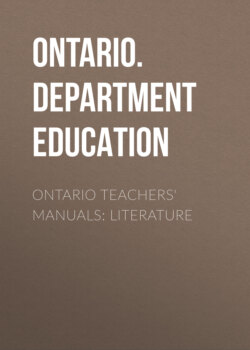Читать книгу Ontario Teachers' Manuals: Literature - Ontario. Department of Education - Страница 23
На сайте Литреса книга снята с продажи.
IN JUNIOR FORMS
ОглавлениеTable of Contents
To introduce children to the world of literature, it is not necessary to wait until they have mastered the art of reading. The introduction should come long before they have learned to read, through listening to good stories told or read to them by others, through hearing suitable poems read or recited with spirit and feeling, and by memorizing nursery rhymes and gems of poetry.
The material to be used in primary grades has already been described. Early work in literature should be correlated with oral composition.
As to the comparative merits of reading and telling, much may be said on each side. In the early stages, telling must, of course, be the predominant if not the exclusive means of communicating the story. The matter and language can thus be better adjusted to the capacity of the individual pupil. The teacher who is familiar with the pupil's home life and surroundings has within his power a means of adapting the story to the attainments of the pupil that even the best writer of children's stories can hardly command. A situation in a story can frequently be made intelligible by reference to the pupil's own experience. Moreover, in telling the story, the teacher's gestures, facial expression, and tone of voice are likely to be more spontaneous and natural than would be the case in reading, and this gives immense assistance in interpreting aright the meaning and spirit of the selection.
Some teachers say that the incident, as in the case of Hawthorne's Tales, is so meagre and the language so exquisite, that the telling seems to be quite inadequate and inferior to the reading of the story. In such cases, variety may be afforded by reading, but generally speaking, it is more effective to tell the story.
The teacher should strive to become a good story-teller. This requires a good voice, animated gesture and facial expression, a good command of English words, power of graphic description and narration, restraint from digression and superfluous detail, and concentration of aim upon some definite point.
In teaching poetry to primary classes, the main object is to lead the pupils to feel the music and realize the imagery. To attain this end, the best beginning is made by a sympathetic and expressive rendering of the passage by the teacher. It can be recited many times incidentally, while he is asking the pupils to look at the pretty pictures suggested by the text. It is not necessary to enter at any length into an analysis of the poem, unless the pictures are arranged in an easy order, such as spring, summer, autumn, winter.
